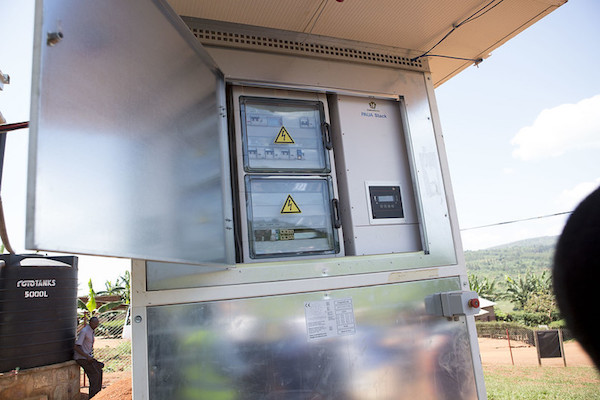SEJournal Online is the digital news magazine of the Society of Environmental Journalists. Learn more about SEJournal Online, including submission, subscription and advertising information.
 |
| A storage facility at a farm in Rwanda using Kigali Amendment-friendly refrigerant technology. The international agreement phases out the greenhouse gas HFCs. Photo: Ministry of Environment — Rwanda, Flickr Creative Commons (CC BY-NC-ND 2.0). |
TipSheet: Air Conditioner HFCs Are on the Way Out — The Kigali Amendment Explained
By Joseph A. Davis
The Senate’s Sept. 21 ratification (may require subscription) of the international climate treaty, the “Kigali Amendment,” means that refrigerants will be changing in air conditioners, refrigerators and cars.
The agreement amends the Montreal Protocol of 1987, which outlawed the cooling agent chlorofluorocarbons, or CFCs, and other fluorinated compounds that destroy the stratospheric ozone layer.
It wasn’t until later that scientists realized that some of the gases used as substitutes for CFCs were potent greenhouse gases. The Kigali Amendment phases out the substitutes, typically the gases called hydrofluorocarbons, or HFCs, which are in very common use as refrigerants.
All this means that environmental journalists may soon be called on to explain what is happening with air conditioning. Some of us are breaking out in a cold sweat. TipSheet is here to help you get ready for the changes ahead.
Why it matters
Now that we’re living through drought, heat waves, record wildfires, epic rains and floods — not to mention the hurricanes — we probably don’t have to spell out why adding more greenhouse gases to the environment is of grave concern.
Climate heating is making life worse for many people in many parts of the world, and will continue to get worse.
HFCs are well over 1,000 times more powerful
in heat-trapping than carbon dioxide, the
greenhouse gas pollutant most often focused on.
Meanwhile, HFCs are well over 1,000 times more powerful in heat-trapping than carbon dioxide, the greenhouse gas pollutant most often focused on. Scientists estimate that if the Kigali Amendment were fully implemented, it would prevent 0.5 degrees Celsius worth of global heating.
But today, in many places, you can walk into an auto parts store and buy a can of R-134a, an HFC that works to recharge most car air conditioning systems. Eventually, you will need something else, but that widely distributed market for such refrigerants is a sign of how hard they may be to control. In fact, there is already an international black market in smuggled HFCs (some mislabeled and unlabeled).
The backstory
One reason why it was politically possible for the chronically deadlocked Senate to do something about HFCs is that it (and industry) has had more than a decade to get used to the idea.
Another reason is that the United States had already begun replacing them. At the end of 2020, Congress passed legislation mandating an HFC phaseout as part of the huge omnibus appropriation bill enacted before Biden officially took office.
The legislation’s HFC element was called the AIM Act, for American Innovation and Manufacturing, and it directs the U.S. Environmental Protection Agency to carry out a phasedown of the family of gases we call HFCs.
After the usual public rulemaking process, in October 2021, the EPA finalized its “HFC Allocation Rule.” The EPA rule would reduce HFCs by 85% over 15 years. You can find a lot more info on the EPA’s HFC phasedown here.
But as they say, history rhymes. So, HFCs were brought into use as a replacement for the ozone-destroying CFCs. And now that we have to phase HFCs out and replace most of their uses, it might be worth thinking through what we replace HFCs with.
Story ideas
- Talk to local auto repair shops and dealers in your area about the HFC phasedown. How do they get their info? Will they follow it?
- Ask the same question of HVAC contractors and repair outfits in your area.
- What happens to used and discarded air conditioning and refrigeration equipment in your area? What are the provisions for the reclamation and reuse of HFCs?
- Identify the agency in your state responsible for regulating HFCs for various uses. What are the rules now and for the future?
- What industries in your area use HFCs for purposes other than refrigeration — for example as foam blowing agents? What are their plans for alternatives?
Reporting resources
- EPA: As the agency responsible for the HFC phasedown rule, the EPA has lots of info about it. Its HFC resource page has information about the phasedown and about technology transitions and other resources.
- North American Sustainable Refrigeration Council: A nonprofit that advocates greener refrigerants and tracks state rules.
- Climate & Clean Air Coalition: A partnership of governments and nongovernmental organizations aimed at promoting clean air.
- National Conference of State Legislatures: This organization representing state lawmaking bodies has a range of HFC resources, including details of a dozen states that have already taken action to reduce them.
[Editor’s Note: Keep up with news on HFCs with EJToday’s headlines service.]
Joseph A. Davis is a freelance writer/editor in Washington, D.C. who has been writing about the environment since 1976. He writes SEJournal Online's TipSheet, Reporter's Toolbox and Issue Backgrounder, and curates SEJ's weekday news headlines service EJToday and @EJTodayNews. Davis also directs SEJ's Freedom of Information Project and writes the WatchDog opinion column.
* From the weekly news magazine SEJournal Online, Vol. 7, No. 35. Content from each new issue of SEJournal Online is available to the public via the SEJournal Online main page. Subscribe to the e-newsletter here. And see past issues of the SEJournal archived here.












 Advertisement
Advertisement 



